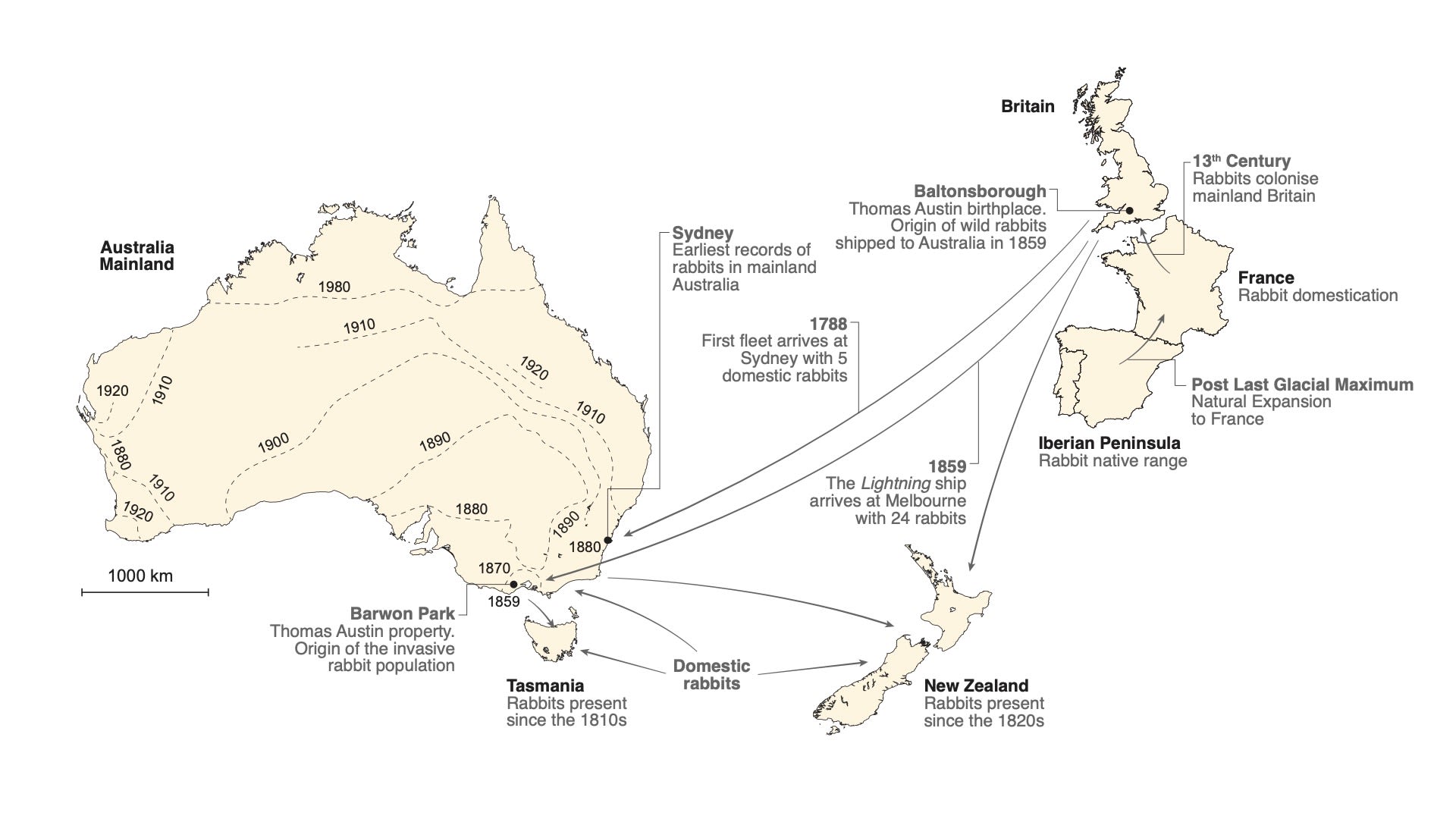新しい研究は、1859年にイギリスから輸送された24匹のウサギが、悪名高い侵略を引き起こしたことを証明し、野生遺伝形質が、それ以前に到着した動物に対して壊滅的な優位性を与えたと論じている。 A new study proves that a single introduction of 24 rabbits shipped from England in 1859 caused the infamous invasion and argues that wild genetic traits gave these animals a devastating advantage over earlier arrivals.
2022-08-22 ケンブリッジ大学
 The colonisation route of the European rabbit from Iberian Peninsula to Australia and New Zealand. Arrows represent introductions. Dashed lines in mainland Australia show the frontier of spread of rabbits across the continent from Thomas Austin’s Barwon Park. Image: Joel Alves
The colonisation route of the European rabbit from Iberian Peninsula to Australia and New Zealand. Arrows represent introductions. Dashed lines in mainland Australia show the frontier of spread of rabbits across the continent from Thomas Austin’s Barwon Park. Image: Joel Alves
国際研究チームは、『PNAS』誌に発表した研究により、ついにこの仮説が遺伝学的に証明され、ウサギの侵入が1回で起こったのか、それとも複数の独立した侵入から起こったのかという論争に決着がついたと発表した。
研究者たちは、1865年から2018年の間にオーストラリア、タスマニア、ニュージーランド、イギリス、フランス各地で野生捕獲された187匹の「ヨーロッパウサギ」から収集した新しい遺伝子データとともに、歴史的記録を研究し、立証した。
<関連情報>
- https://www.cam.ac.uk/stories/dna-profiling-solves-australia-rabbit-plague-puzzle
- https://www.pnas.org/doi/abs/10.1073/pnas.2122734119
オーストラリアの生物学的侵略の引き金となったのは、たった1匹の野ウサギの導入だった A single introduction of wild rabbits triggered the biological invasion of Australia
Joel M. Alves, Miguel Carneiro, Jonathan P. Day, +6, John J. Welch, Janine A. Duckworth, Tarnya E. Cox , Mike Letnic, Tanja Strive , Nuno Ferrand and Francis M. Jiggins
Proceedings of the National Academy of Sciences Published:August 22, 2022
DOI:https://doi.org/10.1073/pnas.2122734119
Significance
Biological invasions are a major global threat and understanding what promotes their success is crucial to developing mitigating policies. While properties of the invasive species or environment have been associated with the success of biological invasions, the role of genetics has been more challenging to demonstrate. Combining genomic and historical data, we provide this link by showing that one of the most iconic biological invasions was triggered by a single introduction of rabbits into Australia, which were likely better adapted to the natural environment due to their wild ancestry. Before the arrival of this lineage, numerous earlier introductions failed to spread, suggesting that the genetic composition of the introduced individuals played a crucial role in determining the invasion’s success.
Abstract
Biological invasions are a major cause of environmental and economic disruption. While ecological factors are key determinants of their success, the role of genetics has been more challenging to demonstrate. The colonization of Australia by the European rabbit is one of the most iconic and devastating biological invasions in recorded history. Here, we show that despite numerous introductions over a 70-y period, this invasion was triggered by a single release of a few animals that spread thousands of kilometers across the continent. We found genetic support for historical accounts that these were English rabbits imported in 1859 by a settler named Thomas Austin and traced the origin of the invasive population back to his birthplace in England. We also find evidence of additional introductions that established local populations but have not spread geographically. Combining genomic and historical data we show that, contrary to the earlier introductions, which consisted mostly of domestic animals, the invasive rabbits had wild ancestry. In New Zealand and Tasmania, rabbits also became a pest several decades after being introduced. We argue that the common denominator of these invasions was the arrival of a new genotype that was better adapted to the natural environment. These findings demonstrate how the genetic composition of invasive individuals can determine the success of an introduction and provide a mechanism by which multiple introductions can be required for a biological invasion.


